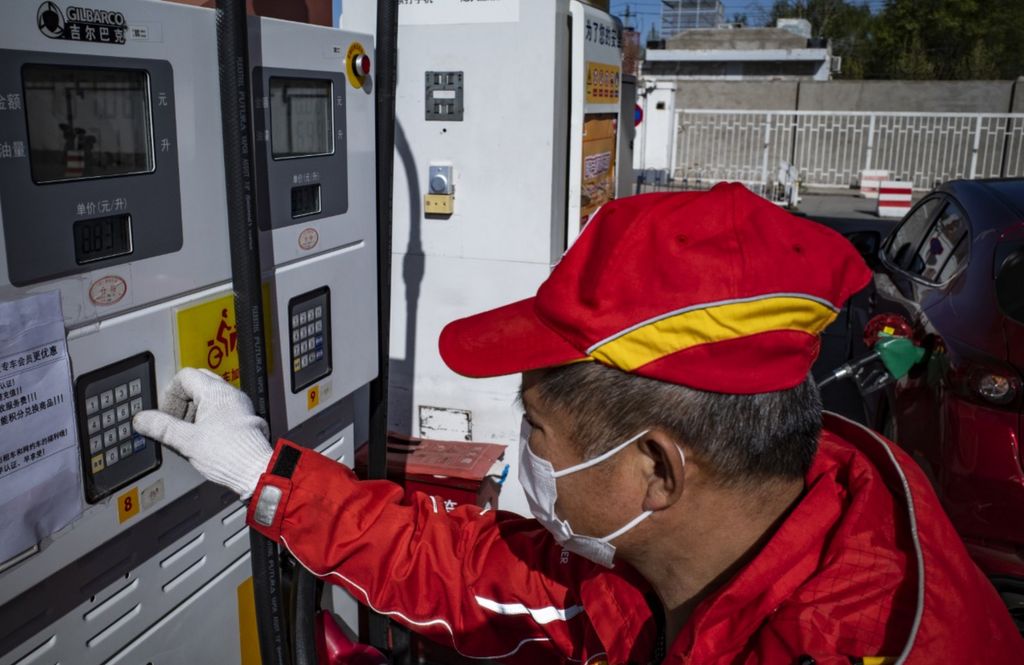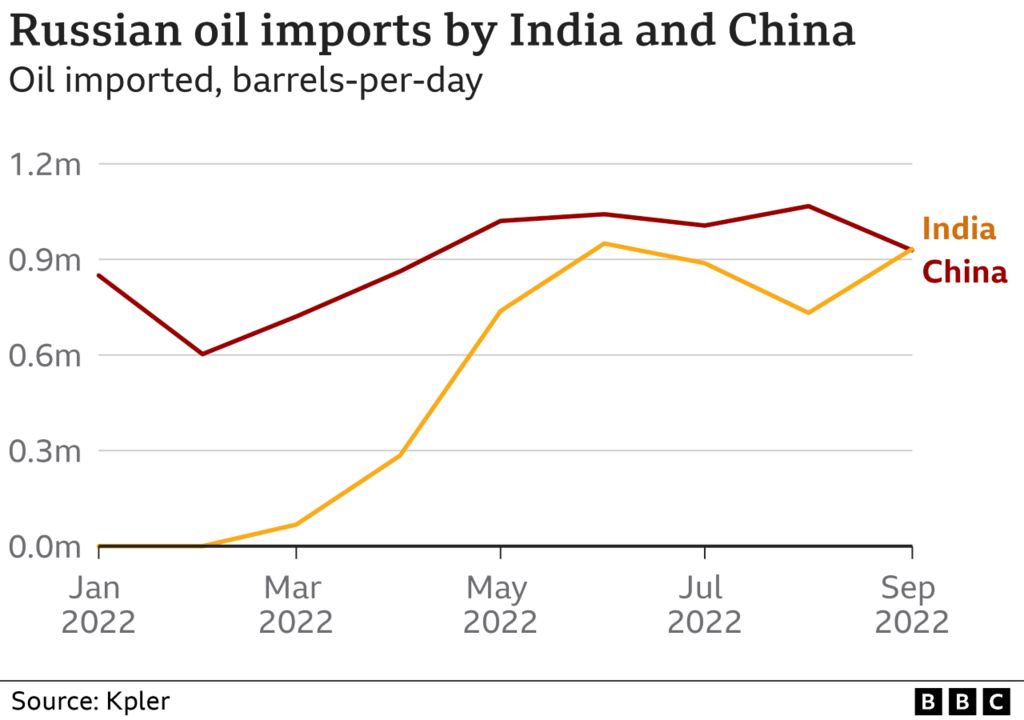BBC:
Ukraine crisis: Russian oil and gas turn to Asia


IMAGE SOURCE,GETTY IMAGES
India and China have been increasingly buying discounted Russian oil as global energy prices remain high and Western nations seek to scale down their reliance on Russian energy.
Facing criticism from Western nations for its Russian oil purchases, India's Foreign Minister S Jaishankar said his country had little choice "when the price of oil is breaking our back".
Where's Russian oil going?
India and China now account for over half of all Russia's seaborne oil exports.
Russia is now China's biggest supplier of oil, taking over from Saudi Arabia in 2022.
In March this year, combined oil imports by China and India from Russia overtook those from the 27 EU member states.

India's purchases of Russian oil have fluctuated this year, falling in February at the start of Russia's invasion of Ukraine, but then rising significantly in the following months.
China's imports of Russian oil have rocketed from a very low base at the start of this year reaching a peak in June and July and largely maintaining these levels through to September.
Myanmar's military regime recently said it would also start importing from Russia.
Sri Lanka, grappling with a severe economic crisis, is taking advantage of discounted Russian oil with three shipments.
In contrast, Japan has made clear it will phase out Russian oil imports, and South Korean imports of Russian crude have fallen.
Cheaper oil is driving the flow to Asia
Following its invasion of Ukraine, Russia had fewer buyers for its Ural crude oil, with some foreign governments and companies deciding to shun its energy exports, and its price started to fall.
At one point Russian Urals crude was more than $30 a barrel cheaper than Brent crude (the global benchmark). By the end of September it was around $20 a barrel cheaper.

India and China have been increasingly buying discounted Russian oil as global energy prices remain high and Western nations seek to scale down their reliance on Russian energy.
Facing criticism from Western nations for its Russian oil purchases, India's Foreign Minister S Jaishankar said his country had little choice "when the price of oil is breaking our back".
Where's Russian oil going?
India and China now account for over half of all Russia's seaborne oil exports.
Russia is now China's biggest supplier of oil, taking over from Saudi Arabia in 2022.
In March this year, combined oil imports by China and India from Russia overtook those from the 27 EU member states.

India's purchases of Russian oil have fluctuated this year, falling in February at the start of Russia's invasion of Ukraine, but then rising significantly in the following months.
China's imports of Russian oil have rocketed from a very low base at the start of this year reaching a peak in June and July and largely maintaining these levels through to September.
Myanmar's military regime recently said it would also start importing from Russia.
Sri Lanka, grappling with a severe economic crisis, is taking advantage of discounted Russian oil with three shipments.
In contrast, Japan has made clear it will phase out Russian oil imports, and South Korean imports of Russian crude have fallen.
Cheaper oil is driving the flow to Asia
Following its invasion of Ukraine, Russia had fewer buyers for its Ural crude oil, with some foreign governments and companies deciding to shun its energy exports, and its price started to fall.
At one point Russian Urals crude was more than $30 a barrel cheaper than Brent crude (the global benchmark). By the end of September it was around $20 a barrel cheaper.

IMAGE SOURCE,GETTY IMAGESImage caption,
India imports more than 80% of its oil
The Indian government has defended its purchases from Russia, saying it has to source oil from where it is cheapest.
The US government has been critical of these purchases, but has little influence over decisions by Asian government as to where they buy their oil.
A plan proposed by the G7 group of nations (UK, US, Canada, France, Germany, Italy and Japan) to cap the price of oil purchased from Russia as a means of limiting Russia's revenue appears largely symbolic.
Russian oil is already significantly cheaper than oil from other sources, and Moscow has said will stop selling to countries that attempt to impose price caps.
What's the impact of sanctions on the oil trade?
Although the price of Russian crude oil is attractive, India's refineries are facing a challenge trying to finance these purchases, because sanctions on Russian banks are affecting payment transactions.
One of the options India is looking at is a system based on local currencies, where Indian exporters to Russia get paid in roubles instead of dollars or euros and imports are paid for in rupees.
China's state-owned oil enterprises are increasingly using the Chinese renminbi rather than the US dollar to finance oil purchases from abroad.

India imports more than 80% of its oil
The Indian government has defended its purchases from Russia, saying it has to source oil from where it is cheapest.
The US government has been critical of these purchases, but has little influence over decisions by Asian government as to where they buy their oil.
A plan proposed by the G7 group of nations (UK, US, Canada, France, Germany, Italy and Japan) to cap the price of oil purchased from Russia as a means of limiting Russia's revenue appears largely symbolic.
Russian oil is already significantly cheaper than oil from other sources, and Moscow has said will stop selling to countries that attempt to impose price caps.
What's the impact of sanctions on the oil trade?
Although the price of Russian crude oil is attractive, India's refineries are facing a challenge trying to finance these purchases, because sanctions on Russian banks are affecting payment transactions.
One of the options India is looking at is a system based on local currencies, where Indian exporters to Russia get paid in roubles instead of dollars or euros and imports are paid for in rupees.
China's state-owned oil enterprises are increasingly using the Chinese renminbi rather than the US dollar to finance oil purchases from abroad.

IMAGE SOURCE,GETTY IMAGES
What's happening to gas exports from Russia?
Nearly 50% of India's total gas requirements come from abroad - mostly from the Gulf States, with very little from Russia.
"Deliveries of Russian LNG (liquefied natural gas) to India are rare" says Antonio Peciccia, a commodity industry expert with Argus media. "We believe five cargoes so far this year, down from seven a year earlier".
China imports most of its gas via pipeline from central Asia. Currently, Turkmenistan is the largest supplier.
Once a new pipeline, known as Power of Siberia, is completed later this decade, Russia may well take over as China's biggest supplier of gas.
China is also increasing its LNG importing capacity from Russia and has signed new deals with Russian companies to transport LNG via the Arctic.

What's happening to gas exports from Russia?
Nearly 50% of India's total gas requirements come from abroad - mostly from the Gulf States, with very little from Russia.
"Deliveries of Russian LNG (liquefied natural gas) to India are rare" says Antonio Peciccia, a commodity industry expert with Argus media. "We believe five cargoes so far this year, down from seven a year earlier".
China imports most of its gas via pipeline from central Asia. Currently, Turkmenistan is the largest supplier.
Once a new pipeline, known as Power of Siberia, is completed later this decade, Russia may well take over as China's biggest supplier of gas.
China is also increasing its LNG importing capacity from Russia and has signed new deals with Russian companies to transport LNG via the Arctic.

IMAGE SOURCE,GETTY IMAGES
"Looking at customs data for August, Russian LNG was actually the most expensive one China took last month," says Mr Peciccia.
This is likely, he says, because China bought LNG from the short-term market which is currently more expensive than long-term contracts.
In September, Russia's Gazprom and the China National Petroleum Corporation agreed to use Russian roubles and yuan instead of dollars to make payments for Russian gas.
"Looking at customs data for August, Russian LNG was actually the most expensive one China took last month," says Mr Peciccia.
This is likely, he says, because China bought LNG from the short-term market which is currently more expensive than long-term contracts.
In September, Russia's Gazprom and the China National Petroleum Corporation agreed to use Russian roubles and yuan instead of dollars to make payments for Russian gas.
No comments:
Post a Comment